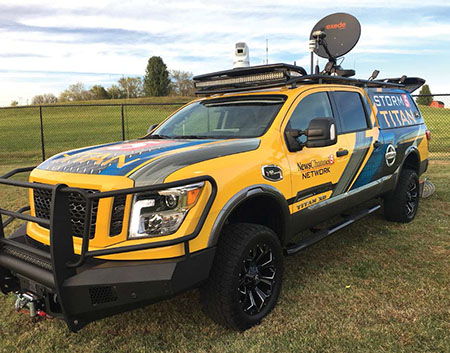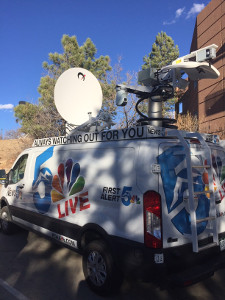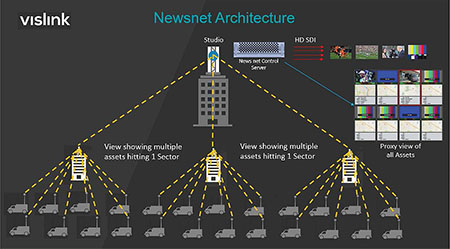Driving Station Workflows in the Field
HAMILTON, N.J.—Besides transporting crews to the news, today’s IP-capable newsgathering vehicles are in demand for seamlessly extending broadcast studio and newsroom workflows into the field. A mix of bonded cellular, IP satellite, conventional satellite and microwave networking systems on board gives truck operators more ways to get vital live shots back to the studio.
Broadcasters also want to combine bonded cellular with dash cam and roof-mounted camera systems. Rather than having to stop or remain parked, bonded cellular lets news vehicle operators transmit live video while they’re driving. This gives viewers a novel new way to see current traffic, weather and other road conditions.

AMT recently built the Storm 5 Titan in a Nissan SUV for WTVF in Nashville, Tenn.
NETWORKING TOOLS
With high demand for advanced networking and backhaul capabilities, two of the industry’s top truck vendors—Frontline Communications and Accelerated Media Technologies (AMT)—say they’re as busy as ever building and retrofitting vehicles designed especially for cellular newsgathering (CNG) or IP newsgathering (IPNG).
For Frontline, sales of news vehicles are up 20 percent this year, according to Steve Williamson, director of sales for the Clearwater, Fla.-based company. “Broadcasters want vehicles that integrate more networking tools to ensure that they can get that critical live shot back from the field, regardless of the weather, geography, or other circumstances,” he said. “For this reason, we’re custom building trucks that integrate multiple high-speed transmission systems, including bonded cellular, Ku-band/Ka-band IP/satellite, among other features, according to the individual customer’s specifications.”
Frontline’s latest truck systems can automatically identify the best signal path for getting a live shot out, and if there’s ever a technical issue with one network, they automatically failover to another.
Popular Products for DSNGSEG’s UHP-1000 hubless VSAT satellite router “enables broadcasters to create a virtual private IP satellite network that they can use to send VoIP calls and data between their studio and vehicles in the field,” according to SEG’s Chris Childs.
Get the TV Tech Newsletter
The professional video industry's #1 source for news, trends and product and tech information. Sign up below.

HAMILTON, N.J.—SEG, a division of WESCO Distribution, Inc., is a reseller of electronics for the broadcast industry, particularly digital satellite newsgathering (DSNG) vehicles. One of their most popular products is the Ericsson AVP 3000 encoder. “One reason for the appeal is that it allows you to have multiple encoder modules on a single RU chassis,” said Chris Childs, director of sales for SEG in Kansas City, Mo., “Up to four signals can be sent simultaneously over different paths, in a mix of codecs and bit rates, from a single chassis.” The AVP 3000 supports compression rates, such as MPEG-2, MPEG-4 and HEVC, as well as IP and ASI outputs. “With this flexibility, you can get your signal out multiple ways, including satellite, bonded cellular and LTE microwave,” Childs continued. SEG sells products to truck vendors, as well as directly to stations that want to replace legacy equipment on their own vehicles.
Also in the SEG portfolio is the Avatec AVQ1022 DVB RF layer monitoring receiver and signal analyzer for DVB-S/S2/S2x, which allows operators to monitor their assigned satellite frequencies, and display the carrier ID of any signal causing signal interference. The FCC mandated carrier ID in September 2017. According to Childs, another product popular for DSNG vehicles is the UHP-1000 hubless VSAT satellite router. “It enables broadcasters to create a virtual private IP satellite network that they can use to send VoIP calls and data between their studio and vehicles in the field,” he said. “This is especially useful in rural and remote places that typically lack cellular service.”
Claudia Kienzle
CNN now uses a new fleet of dual-path CNG trucks built by Frontline on the Ford Expedition XLT 4x4 chassis. CNN recently used these CNG SUVs to provide comprehensive coverage of Hurricanes Irma and Nate, among other breaking news stories.
Besides their dual LiveU encoders, the vehicles have Frontline’s exclusive, fourcamera “Live&Drive” system, a popular feature that allows the driver or on-camera talent in the vehicle to use a pistol-grip controller to switch the dash cam from interior to exterior views. When used with bonded cellular, live video from the dash cam and roof-mounted cameras can be transmitted while the vehicle is moving.
SMALLER CHASSIS
At AMT in Auburn, Mass., President Thomas Jennings also finds that demand for newsgathering vehicles remains strong, despite the rise of portable bonded cellular systems. In fact, today’s compact yet powerful transmission technologies, such as bonded cellular and IP/satellite, allow them to build ever-smaller vehicles.
“Instead of larger body trucks, we’re now able to use smaller SUVs, like the Subaru Forester and Chevy Suburban, and smaller satellite and IP antennas further reduce the vehicle’s profile,” he said. The focus has been on four-wheel drive, maneuverability, and the ability to be driven by inexperienced operators. “Another advantage is that these smaller vehicles can also be paid off quicker for a faster return on investment,” he said.
According to Williamson, “The bonded cellular encoder can also double as the encoder for the IP Ka- and Ku-band IP satellite systems, which saves both money and rack space.” On the Nissan NV and Ford Transit T250 van platforms, Frontline can also install a mast well that allows a retractable 50-foot mast to be stowed while still keeping the stowed vehicle height to under 10.5 feet.
Both Williamson and Jennings say that today’s smaller platforms—like the Ford Transit T250 and Nissan NV high-roof vans—make it easier for the vehicles to pass under low-clearance bridges, fit into tight parking spaces, and get anywhere camera crews need to go.
Despite the trend towards bonded cellular backpacks, Williamson and Jennings say that stations are still investing in newsgathering vehicles because news crews need a quiet place to edit where they can be comfortable and out of the elements. They also want dependable air conditioning, power generators, storage space for video gear, a place to recharge batteries, and the other ergonomic advantages that newsgathering vehicles provide.

IMT Vislink’s newsnet features a bidirectional, high-speed IP wireless data link that also utilizes the broadcaster’s own BAS RF spectrum to send low latency, high-quality live video.
IP BAS-ICS
WJXT-TV4 in Jacksonville, Fla., uses a fleet of news vehicles built by AMT that integrate racks of equipment for video editing and multiple transmission modes. The fleet includes six vehicles—a mix of SUVs and vans—that AMT retrofitted with its ENGenesis LTW. Jennings says LTE microwave such as what AMT is using in ENGenesis, is further revitalizing the news vehicle business by giving broadcasters an innovative way to send secure, two-way, IP-based LTE data communications—between their trucks and studios—over the 2/7GHz BAS spectrum they already use and control.
At WJXT, the News4JAX news teams recently used their “LTE for ENG” vehicles to cover Hurricane Irma in September. “During Hurricane Irma, when cell phone towers were knocked out, and heavy rains made their Ka-band satellite connection impossible, WJXT trucks were still able to get their live signals back because they were using LTE microwave,” Jennings said.
While LTE is the most advanced cellular industry standard, LTE microwave isn’t a cellular bonding system, nor does it use cell towers. Instead, it transmits video, VoIP and other data over the broadcaster’s own dedicated 2/7GHz BAS frequency. Within the reach of their BAS spectrum, broadcasters can use their own licensed BAS bandwidth for free, so it saves them money compared with bonded cellular systems that involve commercial cellular airtime charges that mount over time, according to Jennings.
Compared to the COFDM microwave they previously used on their trucks, LTE has greatly expanded WJXT’s ability to cover live shots, according to James Lowery, director of engineering for the station. “Since we deployed LTE in these trucks, we’ve seen a reduction of over 50 percent of data usage out of these trucks.”
NEWSNET CONNECTION
IMT Vislink’s newsnet is another innovative IP transmission solution making its way onto newsgathering vehicles. This bidirectional, high-speed IP wireless data link also utilizes the broadcaster’s own BAS RF spectrum to send low latency, high-quality live video. According to Williamson, Frontline is currently working on proposals for newsgathering vehicles that will incorporate the IMT Vislink newsnet wireless IP data transmission solution.
Within the BAS coverage area, newsnet extends the station’s IP-based newsroom computer system (NRCS) and studio workflow to the field. It also gives field journalists full access to studio resources, such as media asset management, and lets them tap directly into the NRCS for better collaboration. It also ensures that the right content gets priority by using an uncontested, bidirectional IP connection over the existing BAS channel, with feedback from studio automation.
“Unlike third-party bonded cellular services that charge for usage, newsnet utilizes the BAS RF spectrum that broadcasters already control at no charge. They also don’t need to compete with others for a connection or bandwidth because BAS is a high-bandwidth channel that’s licensed to them for their exclusive use,” said John Payne IV, president of IMT USA, in Hackettstown, N.J. “Within your coverage area, small, low-profile antennas can be used, and newsnet isn’t susceptible to winds, rain, lightning or other conditions that can adversely impact cellular or satellite transmissions.”

